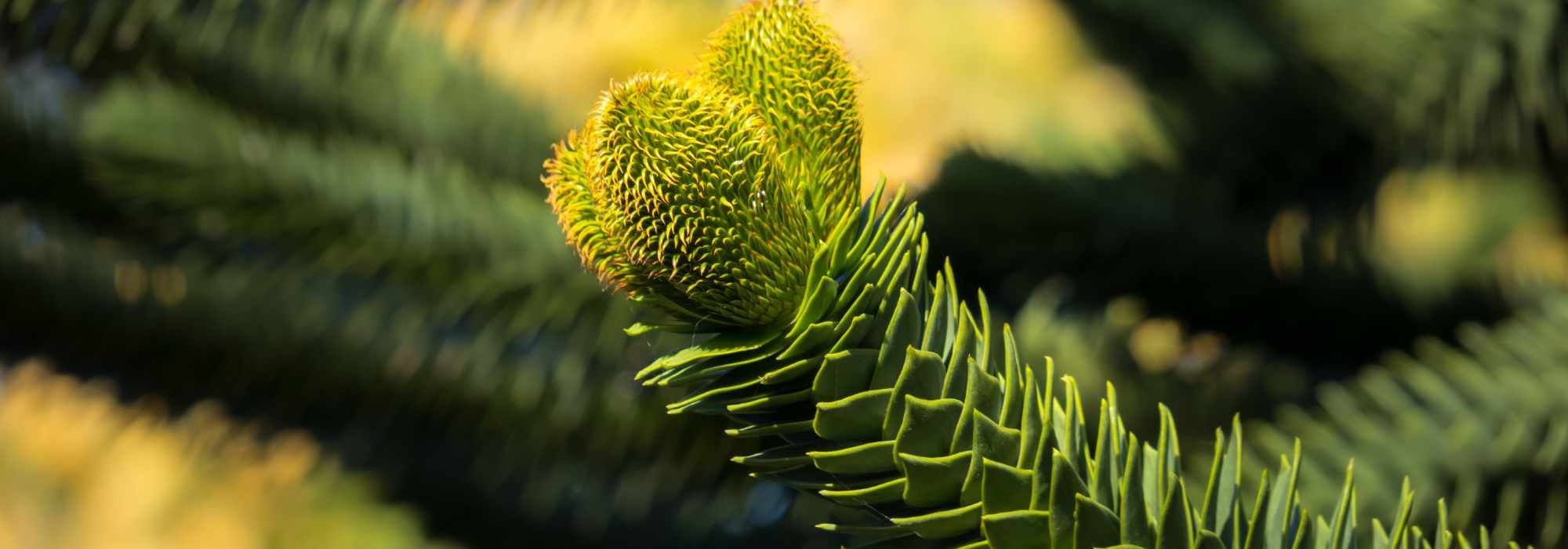
Araucaria - Monkey puzzle tree: planting and caring
Contents
The Araucaria in a nutshell
- The Araucaria stands out with its needle or scale-shaped foliage, giving it an exotic appearance that catches the eye in any garden or green space.
- Also known as the Monkey Puzzle tree, this conifer is native to Chile. As a result, it is more suited to temperate to subtropical climates.
- Make sure to allocate space, as the Araucaria can reach 20 metres in height with a spread of 8 metres.
- These large trees require a sunny to partially shaded location and well-drained soil for optimal growth.
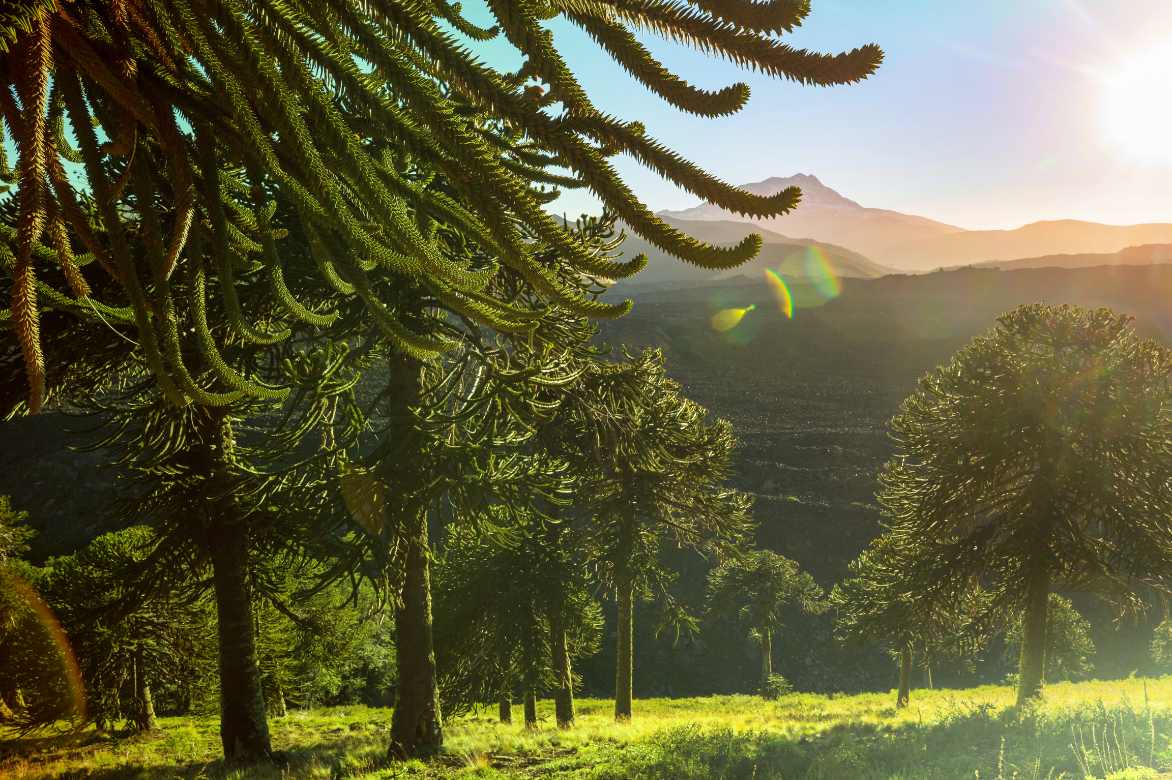
Araucaria araucana
The word from our expert
The Araucaria, commonly known as the “Monkey Puzzle” or “Monkey’s Despair”, is a genus of conifers that has fascinated botanists and gardeners for centuries. Native primarily to the southern hemisphere, this genus includes several species, among which Araucaria araucana and Araucaria heterophylla are the most commonly cultivated. The Araucaria holds significant cultural importance in several regions, notably in New Caledonia and Chile. In landscaping, it is often used as an ornamental tree in large gardens or arboreal parks due to its majestic stature and unique foliage.
From a botanical perspective, the Araucaria exhibits unique characteristics that set it apart from other conifers. Its evergreen foliage, composed of needles or scales, is arranged in spirals along the branches, creating a captivating visual texture. Although Araucarias are typically dioecious, female and male cones are sometimes found on the same tree, a characteristic known as monoecy.
The Araucaria has adapted to a variety of climates, ranging from temperate to subtropical regions. However, it prefers well-drained soil and a sunny to partially shaded location for optimal growth. In terms of maintenance, the Araucaria is relatively undemanding. Regular watering and minimal fertilisation are generally sufficient.
Botany and description
Botanical data
- Latin name Araucaria araucana
- Family Araucariaceae
- Common name Monkey Puzzle - Monkey's Despair
- Flowering April-May
- Height up to 20 m
- Exposure sun
- Soil type rich and light, fresh but well-drained
- Hardiness -12°C
The botanical genus Araucaria belongs to the Araucariaceae family and derives its name from the Araucanía region in Chile, where two species of the genus are native: the Chilean Araucaria and the Araucaria angustifolia. Araucarias were already present during the Mesozoic era, as evidenced by fossils discovered in various regions of the world, including India, Africa, America, and Australia.
Regarding their current geographical distribution, it is much more limited and primarily confined to specific regions. For example, a large proportion of the genus’s species are endemic to New Caledonia, with 16 out of the 20 recorded species worldwide, where they have adapted to various altitudes and soil types. These trees are found in coastal areas, low and mid-altitude zones, and some peaks above 1,000 metres.
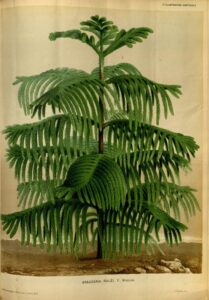
Araucaria rulei, botanical plate, circa 1870
Regarding the different species, the Chilean Araucaria or “Monkey Puzzle” (Araucaria araucana) is the most commonly cultivated in Europe and the hardiest in temperate climates. The Norfolk Island Pine (Araucaria heterophylla) and the Cook Pine (Araucaria columnaris) are also frequently planted in warm coastal regions of the world and temperate areas with very mild winters.
Araucarias are gregarious species that never form dense forest stands. They prefer steep, sunny slopes and are often planted as ornamental trees in large gardens or parks. Several species are also cultivated for their wood or for aesthetic reasons.
The trunk of these conifers is typically very straight and may be covered with a resinous bark, rough and thick. This bark can vary in colour, ranging from greyish to reddish, and can account for up to 25% of the trunk’s volume. It often features a polygonal tile-like pattern corresponding to the scars of former branch insertions.
The stems or branches are arranged in a spiral and can be horizontal or slightly concave. When the tree is young, the lower branches often touch the ground, giving the tree a pyramidal shape. As it ages, the lower branches fall away, the trunk becomes clear, and the crown tends to become more open, taking on an umbrella-like shape.
The “leaves” of Araucarias are very distinctive. They are either needle-like or triangular scales, dense and overlapping, forming a cylindrical sheath around the branches. These leaves are leathery, evergreen, and long-lived, lasting from 10 to 15 years.
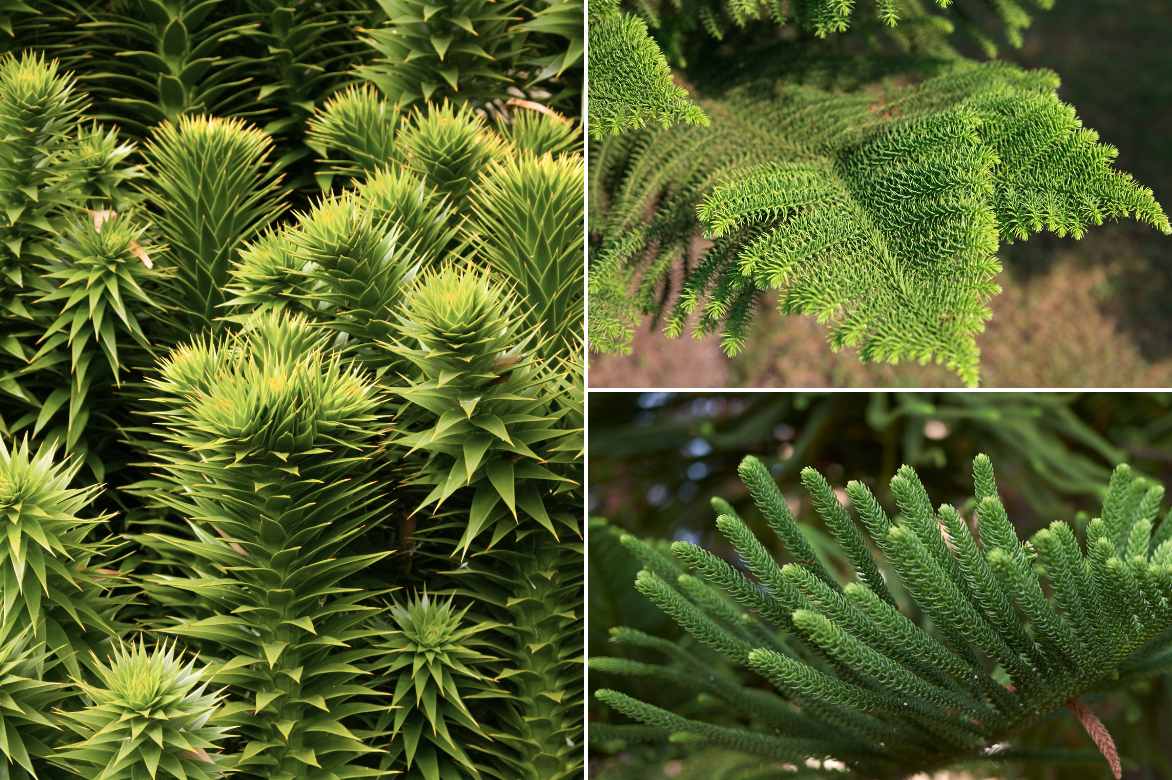
The different types of “foliage”: on the left, that of Araucaria araucana, top right that of A. excelsa, and bottom right that of A. heterophylla.
Regarding flowers and cones, Araucarias are generally dioecious, meaning that male and female cones are usually found on separate trees. However, it can happen that Araucarias practice monoecy by producing male and female cones on the same individual. Male cones are elongated and found at the ends of branches. They are yellowish-brown at maturity and bear several pollen sacs. The female cones are rather globose and can reach the size of a melon. They consist of about 700 scales and take approximately 18 months to 3 years to mature. Once mature, they disintegrate to release the winged seeds, which are often edible.
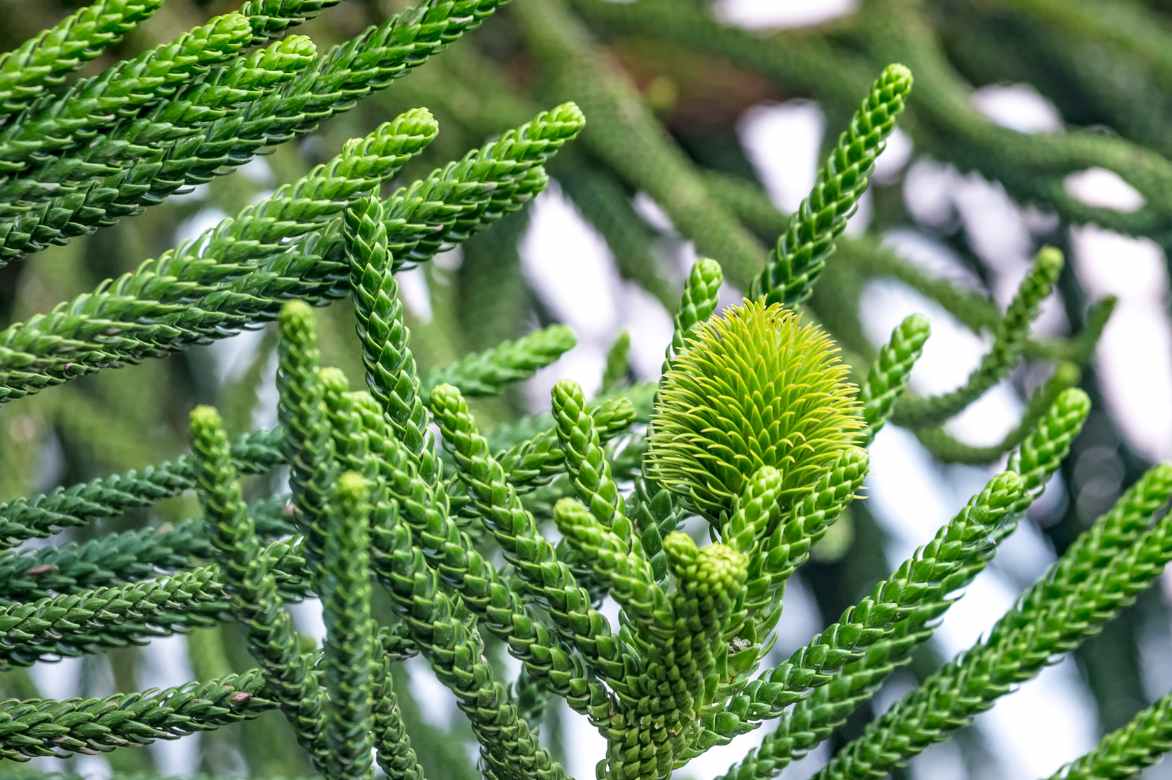
Female cone of Araucaria columnaris
It is worth noting that Araucaria is also adapted to withstand fires, thanks to its thick bark, the protection of its buds, and its ability to produce buds directly on the trunk (epicormic buds). It is therefore found in areas regularly affected by human-induced fires or near active volcanoes.
The main species of _Araucaria_
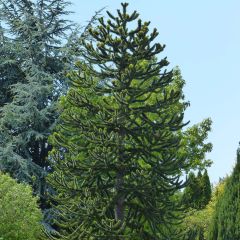
Araucaria araucana - Monkey Puzzle
- Hauteur à maturité 15 m
Planting the Araucaria
Where to Plant?
These trees prefer a sunny location but can also tolerate partial shade. Ensure the tree receives at least a few hours of direct sunlight each day to encourage vigorous growth.
The type of soil is also crucial for the health of the Araucaria, as they prefer well-drained soil rich in organic matter. Avoid clay or overly wet soils, as they can lead to drainage issues and affect the tree’s growth.
Additionally, these trees are best suited to temperate to subtropical climates and may not withstand extremely cold temperatures. The Araucaria is hardy only down to -12°C.
Please note: The Araucaria is a tree that can reach a considerable size, so it’s important to consider spacing when planting. Ensure you leave enough space between the Araucaria and other plants (especially large trees) or nearby structures: allow for about 15 metres.
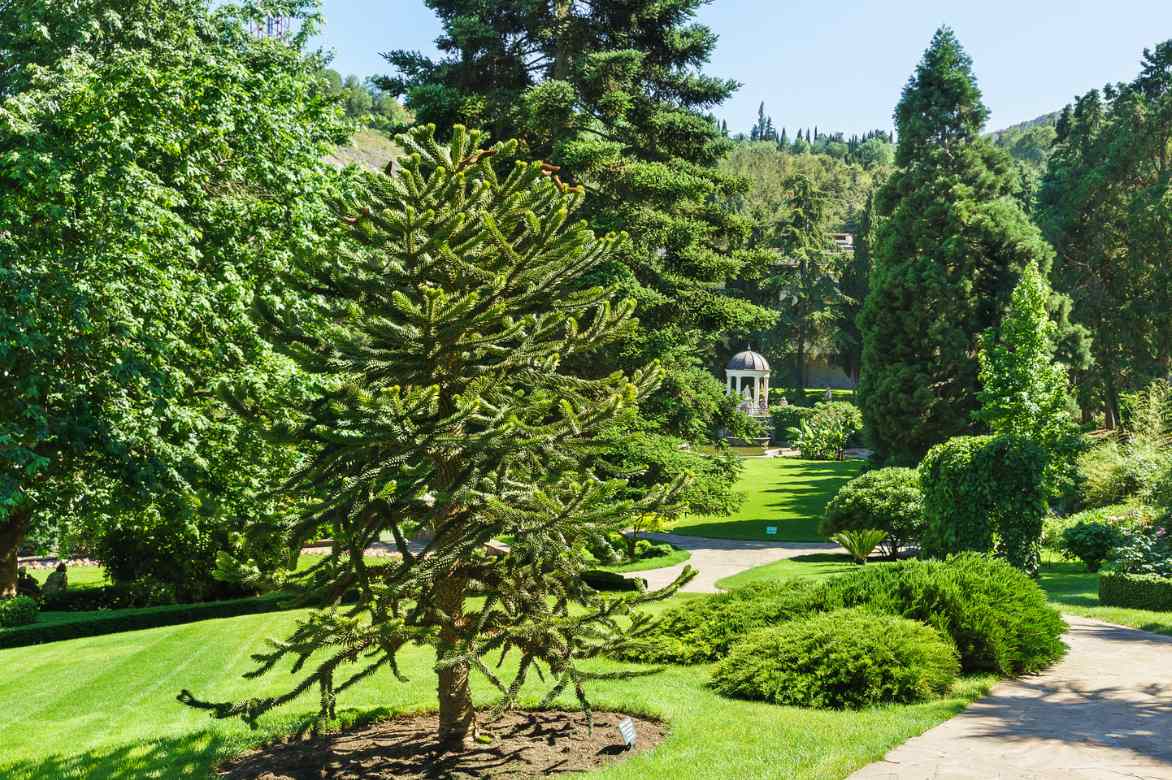
Araucaria araucana: a tree suited to large gardens or parks.
When to Plant?
Spring is often considered the ideal time to plant an Araucaria. The milder temperatures and longer days provide optimal conditions for the tree to establish itself. This also gives the Araucaria enough time to acclimatise before winter arrives.
However, autumn is another favourable time for planting the Araucaria. The cooler temperatures and more regular rainfall help reduce water stress, allowing the tree to establish more easily.
How to Plant?
The first step is to prepare the soil. The Araucaria prefers well-drained soil rich in organic matter. Before planting, it’s advisable to work the soil by incorporating compost and/or organic matter.
- Soak the pot of your Araucaria in a bucket of water for a few minutes to thoroughly rehydrate the root ball
- Dig a hole twice as deep and wide as the volume of the tree’s root ball and loosen the soil at the bottom of the hole
- Throw a few handfuls of well-rotted compost into the bottom of the hole
- If your soil is heavy, you can add some sand or even a few gravel stones to improve drainage
- Place the remaining root ball at the bottom of the hole, spreading the roots out if possible
- Fill the hole with the excavated soil, previously loosened
- Gently firm the soil around the tree with your hands (not your feet!)
- Water the base with 10 litres of water to reduce the risk of “air pockets” between the roots and the soil
- Apply mulch to protect the young tree from drought or plant a few small ground-cover plants at the base (Bugle, Sweet Woodruff, Glechoma, Geranium macrorrhizum…).
Note: Staking an Araucaria at planting can be useful in certain circumstances, especially if the tree is planted in an area exposed to strong winds. Staking helps stabilise the tree while it establishes its root system, which is particularly important during the first few months after planting. If you’d like to learn more, read Should You Always Stake Trees?
Pruning and Maintenance
Pruning
The Araucaria requires little pruning. In fact, excessive pruning can even be harmful to it. If you need to prune your Araucaria, do so with caution. Remove only the dead or damaged branches and avoid cutting the main branches, as this can unbalance the tree and affect its future growth.
Maintenance
Maintenance for the Araucaria is quite minimal. These trees prefer well-drained soil and appreciate regular watering, especially during dry periods. An organic mulch around the base of the tree can help retain moisture and provide essential nutrients.
Fertilisation
Fertilisation is generally not necessary for the Araucaria, especially if the tree is planted in soil rich in organic matter. However, a balanced fertiliser can be applied in spring to encourage vigorous growth.
Diseases and potential parasitic issues
Araucarias can be susceptible to certain types of fungal diseases and parasitic infections, though this is relatively rare.
Symptoms such as yellowing needles or spots on the leaves may indicate a fungal infection, such as rust caused by the fungus Mikronegeria fagi. In such cases, a natural fungicidal treatment may be necessary to control the disease.
Parasitic pests such as aphids and scale insects can also cause problems. These small insects feed on the tree’s sap, weakening the Araucaria and making it more susceptible to diseases.
Multiplication
- Propagation by seed of the Araucaria
The most common method for propagating the Araucaria is by seed. The seeds are harvested from the female cones, which naturally disintegrate to release the winged seeds. Once the seeds are harvested, they should be sown in a well-draining substrate (moist sand or very light compost) and kept at a constant temperature of around 20 to 25 °C. Germination can take several weeks, or even several months. It is crucial to keep the substrate moist but not waterlogged to encourage germination.
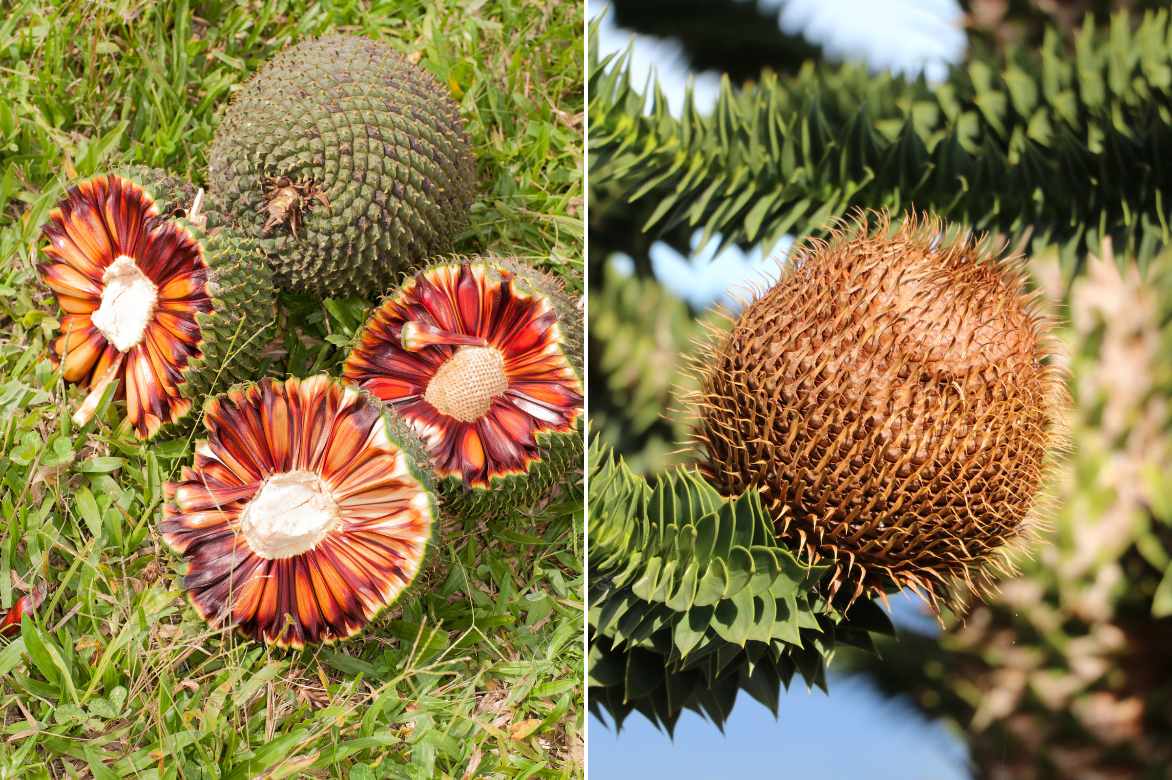
Araucaria seeds on female cones
- Propagation by cuttings of the Araucaria
Propagation by cuttings is less common but still possible. This method involves taking a cutting of about 15 to 20 cm in length from a healthy tree. The cutting is then planted in a mixture of compost and sand and kept at a constant temperature. Rooting can take several months, and the results are variable.
Associating the Monkey's Despair
Creating a harmonious and beautiful scene around an Araucaria requires careful consideration of the colours, textures, and heights of the surrounding plants. The Araucaria, with its needle or scale-like leaves and its majestic habit, is already a centrepiece in any garden. It may therefore be wise to pair it with plants that complement rather than compete with its appearance.
At the base and around the Araucaria, consider perennial plants with evergreen foliage such as certain ferns (for example, Polystichum neolobatum), which add a soft texture and deep green that contrasts well with the Araucaria’s more rigid foliage. Hostas can also be a good option, as they offer a wide variety of leaf colours and textures.
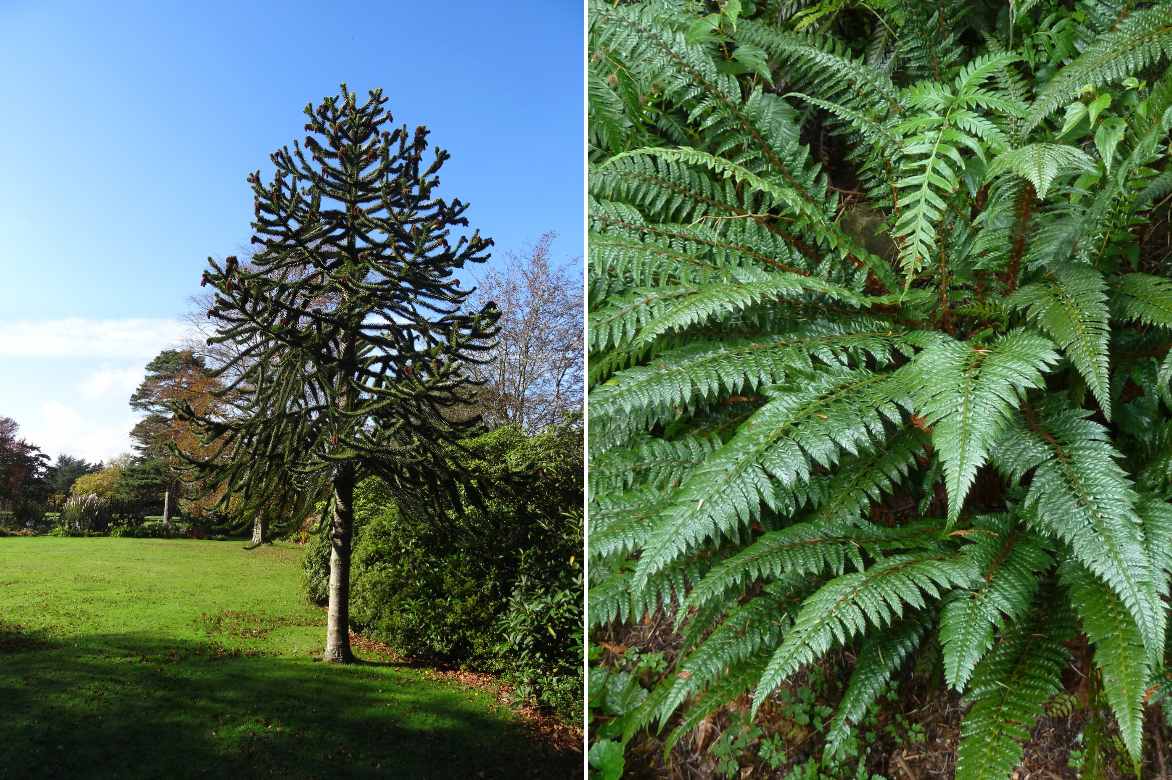
Araucaria araucana and Polystichum neoloblatum (© Wendy Cutler)
To add colour, consider flowering plants that bloom in different seasons. Azaleas and rhododendrons are excellent choices for spring, while hydrangeas can add a splash of colour in summer. Cyclamens, on the other hand, are perfect for adding interest in autumn and winter.
If you wish to add other trees or bushes, opt for those with a different leaf shape or texture to create an interesting contrast. For example, a Himalayan birch with white bark can be an excellent complement, as can a Japanese maple with delicate leaves.
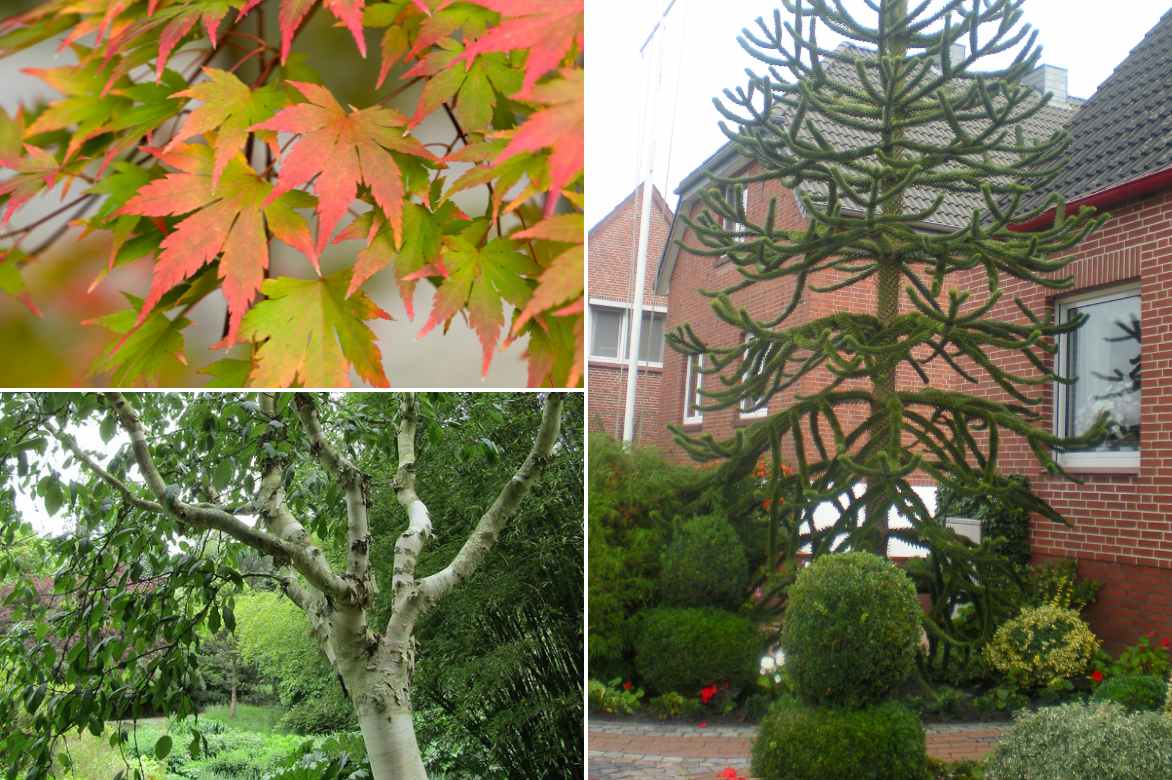
The majestic Araucaria araucana, surrounded by a Japanese maple and a Himalayan birch (© Leonora Enking)
To cover the ground, ground covers such as ivy or periwinkle can be used to fill empty spaces and add a touch of greenery. They are also useful for controlling weeds.
Anecdotes
- The name “Monkey Puzzle” is often attributed to the Araucaria araucana. This name comes from the peculiar arrangement of its branches and thorny leaves, which would make the tree difficult to climb, even for a monkey. However, no large primates inhabit the natural range of this tree. Therefore, it is unknown whether it is truly difficult for a monkey to climb…
- Some specimens of Araucaria araucana have been estimated to be over 1,000 years old, making them living witnesses to history.
- In New Caledonia, where several species of Araucaria are endemic, these trees hold great cultural significance. They are often associated with local legends and are considered symbols of strength and longevity.
- The Chilean Araucaria became the national tree of Chile in 1990.
- The seeds of certain Araucaria species are edible and even serve as a food source for local populations in some regions. They are often compared to pine nuts in terms of taste and texture. But, when in doubt, do not consume the seeds of your Araucaria!!
To go further
- Focus on Araucaria seeds with our feature Araucaria: discover this conifer with edible seeds
- Find other large conifers in our online nursery.
- But if it’s rarity or botanical curiosity that catches your eye, you can also choose rare and unusual conifers.
- Subscribe!
- Contents
































Comments